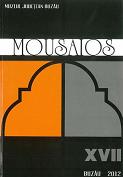O spadă medievală inedită din colectiile Muzeului Judetean de Istorie Brasov
A medieval sword from the Brasov County Museum of History Collection
Author(s): Florin MoţeiSubject(s): Archaeology
Published by: Muzeul Judetean Buzău
Keywords: sword; typology
Summary/Abstract: In the heritage of Brasov County Museum of History, at the inventory number 958 IM, discovered at Codlea, is a fragmentary iron sword which so far has not joined the views of historians specializing in military art. This piece was placed in the category of "treasure" by order of the Ministry of culture no. 2419/01.07.2008. The sword, which keeps the button, the grip, the guard and a part of the blade, is fairly well preserved, until recently being exposed in the exhibition of the Museum of Brasov. The blade, fragmentary, has a length of 405 mm and a width of 50 mm and is equipped on both sides with a median alveola that go up to the base of the handle. The handle, rectangular in cross-section, length 143 mm and ends with a hemispherical shape button, can lead to employment in the swords of a handful and a half type. Guard, with rectangular side profile 11 mm, length 260 mm. What is important in this piece is the coat of arms or the mark of the master in the middle of the blade. This detail has the shape of a shield around a heart and a cross. Swords marked we find in South-East Europe, of Sabac (Aleksić 2007, p. 123, fig. 35), Kamarno (Aleksić 2007 pl 1\/3) or Zeta Near Podgorica (Aleksić 2007, pl. 8\/1). This type of mark I've not encountered in all studied bibliography. This type of sword is spread on the territory of Romania in Transylvania, who was made seven discoveries in six municipalities, Codlea (two pieces), Sânpetru in the County of Brasov, Vurpăr and Şelimbăr in Sibiu County, Grid in Hunedoara County, a piece of the Sighişoara Museum's collections to the City Center and a piece of the Slătineanu collection. Worth mentioning is the fact that the three pieces from the collections of the Museum of the History of Brasov County, two being published by Mr. Zeno Karl Pinter (Pinter, 1999, p. 118-121), the third being the one to which we refer, all three pieces can be placed in the timeline proposed in the work above mentioned. Mr. Zeno-Karl Pinter, based on the discovery of a blade in processing and an unfinished button at Şelimbăr, believes that this type of sword could be worked in Transylvania (Pinter, 1999, p. 121). Also the sababathy historian put these findings on account of the presence of Germanic and Teutonic Knights in the Burzenland and in Sibiu area between the end of the 12th century and the middle of the 13th century (Pinter, 1999, p. 121). In fact these swords would be the only archaeological testimonies that could secure to certify the presence of the Teutonic order in the Carpathians area. But it must be specified that such weapons appear in all South-East european space (Aleksic 2007). Thus, the paper presents five tipologies of various areas of Europe which discusses this type of sword: R. E. Oakeshott (Oakeshott 1964), A. Ruttkay (Ruttkay 1975; Ruttkay 1976), A. Geibig(Geibig 1989; Geibig 1991).
Journal: Mousaios
- Issue Year: 2012
- Issue No: 17
- Page Range: 203-212
- Page Count: 10
- Language: Romanian

